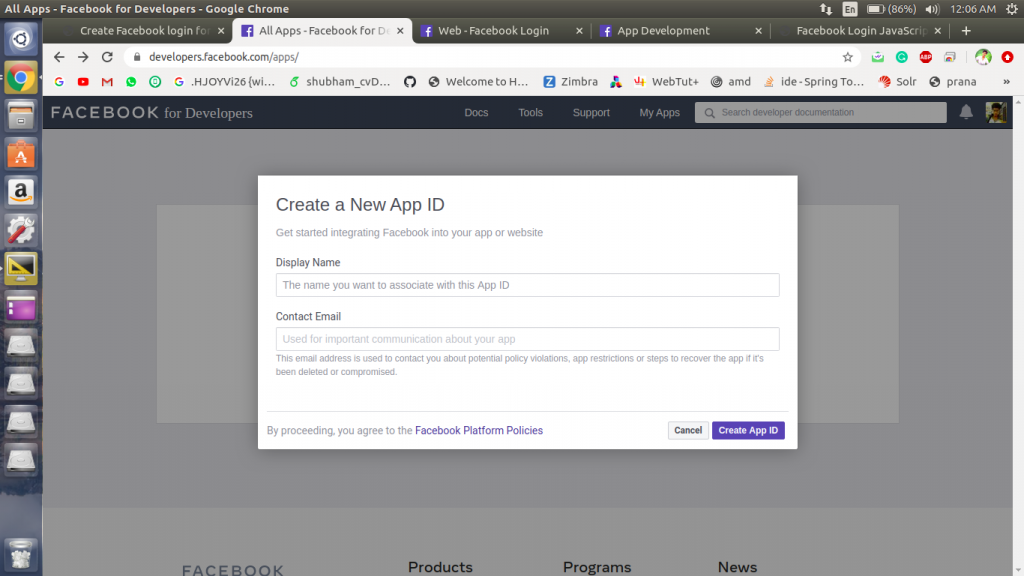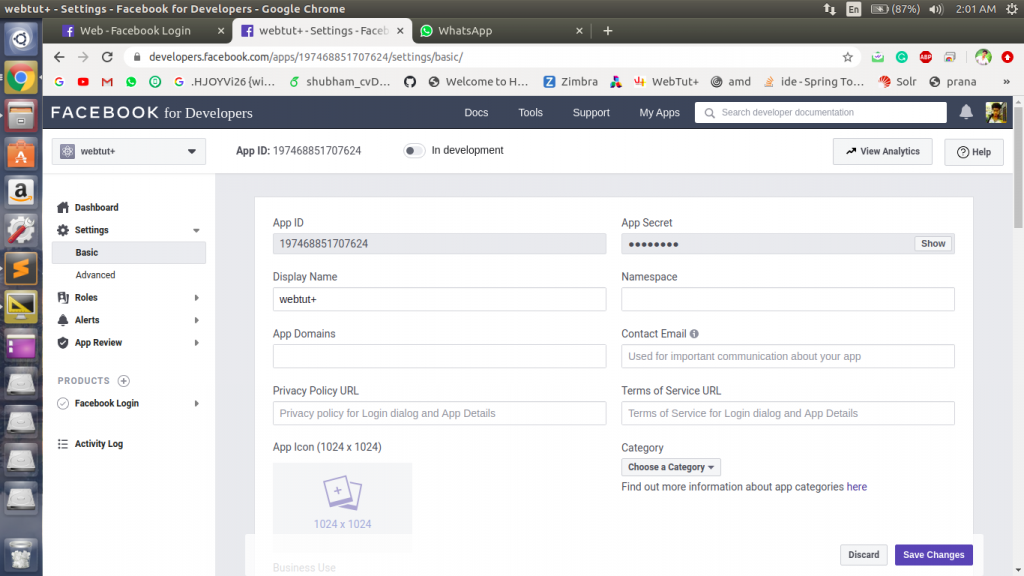So. Made a new website and want an easy login from Facebook. Facebook has a Javascript SDK and we are going to utilize that for creating FB login for our website.
All References from : https://developers.facebook.com
1. Create a facebook App
You need to create a facebook app for your website and get app ID and access to facebook javascript api.
Go to : https://developers.facebook.com/apps/
Click on Add new app and choose the website.

After Creating an APP,
1. In Settings –> Basic you will get an APP ID and APP Secret.
2. In Settings –> Advanced you will get an API Version.
We need that keep those with you.


2. Use Javascript SDK to create login.
window.fbAsyncInit = function() {
FB.init({
appId : '{your-app-id}',
cookie : true,
xfbml : true,
version : '{api-version}'
});
FB.AppEvents.logPageView();
};
(function(d, s, id){
var js, fjs = d.getElementsByTagName(s)[0];
if (d.getElementById(id)) {return;}
js = d.createElement(s); js.id = id;
js.src = "https://connect.facebook.net/en_US/sdk.js";
fjs.parentNode.insertBefore(js, fjs);
}(document, 'script', 'facebook-jssdk'));Here Put your APP ID and the version you are using. The code given has been created using reference from the Facebook developer’s website. So now coming to the point. I will show the part of the code that you need to edit.
function testAPI() {
console.log('Welcome! Fetching your information.... ');
FB.api('/me?fields=name,email,first_name,last_name,gender,locale', function(response) {
console.log('Successful login for: ' + response.name);
var string = 'Thanks for logging in, <h2><strong>' + response.name + '!</strong></h2>' ;
string += '<p> Your Email : '+ response.email + '</p> ';
document.getElementById('status').innerHTML = string;
});
}Here, we make a login call and get a response .
Specify the things you want to receive in response. Here '/me?fields=name,email,first_name,last_name,gender,locale'
Now, you can access to all those using response._property_.
Complete Code-
<!DOCTYPE html>
<html>
<head>
<title>Facebook Login JavaScript Example</title>
<meta charset="UTF-8">
</head>
<body>
<script>
function statusChangeCallback(response) { // Called with the results from FB.getLoginStatus().
console.log('statusChangeCallback');
console.log(response); // The current login status of the person.
if (response.status === 'connected') { // Logged into your webpage and Facebook.
testAPI();
} else { // Not logged into your webpage or we are unable to tell.
document.getElementById('status').innerHTML = 'Please log ' +
'into this webpage.';
}
}
function checkLoginState() { // Called when a person is finished with the Login Button.
FB.getLoginStatus(function(response) { // See the onlogin handler
statusChangeCallback(response);
});
}
window.fbAsyncInit = function() {
FB.init({
appId: '197468851707624',
cookie: true, // Enable cookies to allow the server to access the session.
xfbml: true, // Parse social plugins on this webpage.
version: 'v7.0' // Use this Graph API version for this call.
});
// Now that we've initialized the JavaScript SDK, we call
// FB.getLoginStatus(). This function gets the state of the
// person visiting this page and can return one of three states to
// the callback you provide. They can be:
//
// 1. Logged into your app ('connected')
// 2. Logged into Facebook, but not your app ('not_authorized')
// 3. Not logged into Facebook and can't tell if they are logged into
// your app or not.
//
// These three cases are handled in the callback function.
FB.getLoginStatus(function(response) { // Called after the JS SDK has been initialized.
statusChangeCallback(response); // Returns the login status.
});
};
(function(d, s, id) {
var js, fjs = d.getElementsByTagName(s)[0];
if (d.getElementById(id)) {
return;
}
js = d.createElement(s);
js.id = id;
js.src = "https://connect.facebook.net/en_US/sdk.js";
fjs.parentNode.insertBefore(js, fjs);
}(document, 'script', 'facebook-jssdk'));
function testAPI() {
console.log('Welcome! Fetching your information.... ');
FB.api('/me?fields=name,email,first_name,last_name,gender,locale', function(response) {
console.log('Successful login for: ' + response.name);
var string = 'Thanks for logging in, <h2><strong>' + response.name + '!</strong></h2>';
string += '<p> Your Email : ' + response.email + '</p> ';
document.getElementById('status').innerHTML = string;
});
}
</script>
<!-- The JS SDK Login Button -->
<fb:login-button scope="public_profile,email" onlogin="checkLoginState();">
</fb:login-button>
<div id="status">
</div>
<!-- Load the JS SDK asynchronously -->
<script async defer crossorigin="anonymous" src="https://connect.facebook.net/en_US/sdk.js"></script>
</body>
</html>If you are having understanding some piece of code. Please comment here, We are here to help you out.